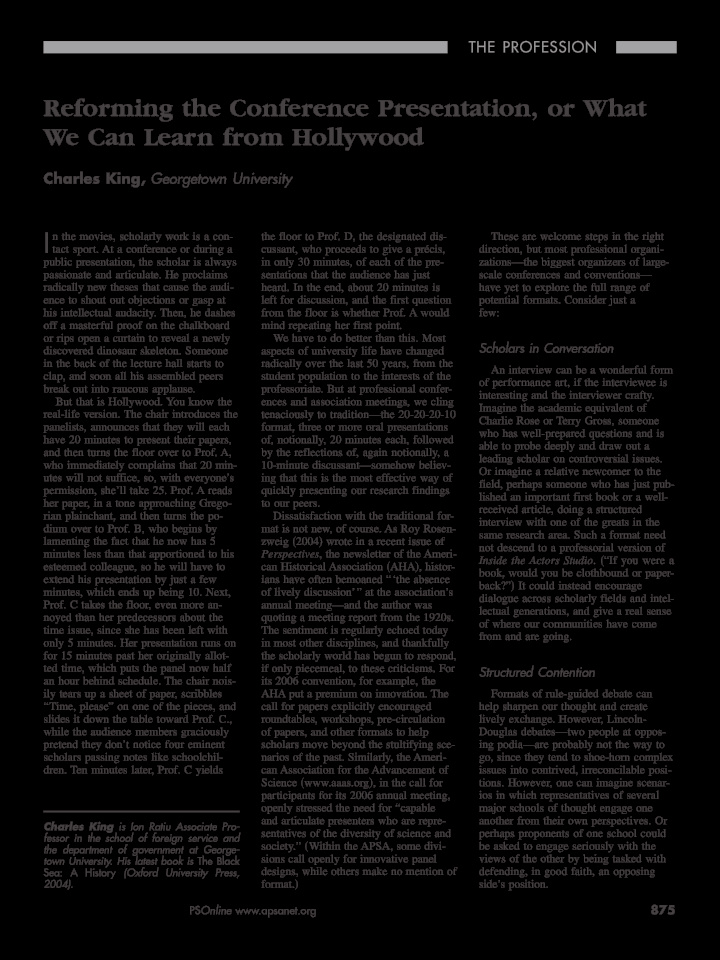



THE PROFESSION Reforming the Conference Presentation, or What We Can Learn from Hollywood Charles King, Georgetown University I n the movies, scholarly work is a con- the floor to Prof. D, the designated dis- These are welcome steps in the right tact sport. At a conference or during a cussant, who proceeds to give a précis, direction, but most professional organi- public presentation, the scholar is always in only 30 minutes, of each of the pre- zations—the biggest organizers of large- passionate and articulate. He proclaims sentations that the audience has just scale conferences and conventions— radically new theses that cause the audi- heard. In the end, about 20 minutes is have yet to explore the full range of ence to shout out objections or gasp at left for discussion, and the first question potential formats. Consider just a his intellectual audacity. Then, he dashes from the floor is whether Prof. A would few: off a masterful proof on the chalkboard mind repeating her first point. or rips open a curtain to reveal a newly We have to do better than this. Most Scholars in Conversation discovered dinosaur skeleton. Someone aspects of university life have changed in the back of the lecture hall starts to radically over the last 50 years, from the An interview can be a wonderful form clap, and soon all his assembled peers student population to the interests of the of performance art, if the interviewee is break out into raucous applause. professoriate. But at professional confer- interesting and the interviewer crafty. But that is Hollywood. You know the ences and association meetings, we cling Imagine the academic equivalent of real-life version. The chair introduces the tenaciously to tradition—the 20-20-20-10 Charlie Rose or Terry Gross, someone panelists, announces that they will each format, three or more oral presentations who has well-prepared questions and is have 20 minutes to present their papers, of, notionally, 20 minutes each, followed able to probe deeply and draw out a and then turns the floor over to Prof. A, by the reflections of, again notionally, a leading scholar on controversial issues. who immediately complains that 20 min- 10-minute discussant—somehow believ- Or imagine a relative newcomer to the utes will not suffice, so, with everyone’s ing that this is the most effective way of field, perhaps someone who has just pub- permission, she’ll take 25. Prof. A reads quickly presenting our research findings lished an important first book or a well- her paper, in a tone approaching Grego- to our peers. received article, doing a structured rian plainchant, and then turns the po- Dissatisfaction with the traditional for- interview with one of the greats in the dium over to Prof. B, who begins by mat is not new, of course. As Roy Rosen- same research area. Such a format need lamenting the fact that he now has 5 zweig ~ 2004 ! wrote in a recent issue of not descend to a professorial version of minutes less than that apportioned to his Perspectives , the newsletter of the Ameri- Inside the Actors Studio . ~ “If you were a esteemed colleague, so he will have to can Historical Association ~ AHA ! , histor- book, would you be clothbound or paper- extend his presentation by just a few ians have often bemoaned “‘the absence back?” ! It could instead encourage minutes, which ends up being 10. Next, of lively discussion’” at the association’s dialogue across scholarly fields and intel- Prof. C takes the floor, even more an- annual meeting—and the author was lectual generations, and give a real sense noyed than her predecessors about the quoting a meeting report from the 1920s. of where our communities have come time issue, since she has been left with The sentiment is regularly echoed today from and are going. only 5 minutes. Her presentation runs on in most other disciplines, and thankfully for 15 minutes past her originally allot- the scholarly world has begun to respond, ted time, which puts the panel now half if only piecemeal, to these criticisms. For Structured Contention an hour behind schedule. The chair nois- its 2006 convention, for example, the ily tears up a sheet of paper, scribbles AHA put a premium on innovation. The Formats of rule-guided debate can “Time, please” on one of the pieces, and call for papers explicitly encouraged help sharpen our thought and create slides it down the table toward Prof. C., roundtables, workshops, pre-circulation lively exchange. However, Lincoln- while the audience members graciously of papers, and other formats to help Douglas debates—two people at oppos- pretend they don’t notice four eminent scholars move beyond the stultifying sce- ing podia—are probably not the way to scholars passing notes like schoolchil- narios of the past. Similarly, the Ameri- go, since they tend to shoe-horn complex dren. Ten minutes later, Prof. C yields can Association for the Advancement of issues into contrived, irreconcilable posi- Science ~ www.aaas.org ! , in the call for tions. However, one can imagine scenar- participants for its 2006 annual meeting, ios in which representatives of several openly stressed the need for “capable major schools of thought engage one and articulate presenters who are repre- another from their own perspectives. Or Charles King is Ion Ratiu Associate Pro- sentatives of the diversity of science and perhaps proponents of one school could fessor in the school of foreign service and society.” ~ Within the APSA, some divi- be asked to engage seriously with the the department of government at George- sions call openly for innovative panel views of the other by being tasked with town University. His latest book is The Black Sea: A History (Oxford University Press, designs, while others make no mention of defending, in good faith, an opposing 2004). format. ! side’s position. 875 PS Online www.apsanet.org
Recommend
More recommend